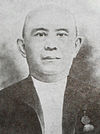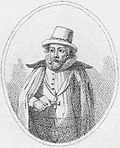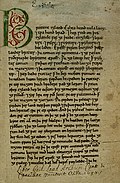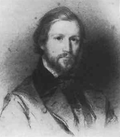Wikipedia:Today's featured article/November 2013
| << | Today's featured articles for November 2013 | >> | ||||
|---|---|---|---|---|---|---|
| Su | Mo | Tu | We | Th | Fr | Sa |
| 1 | 2 | |||||
| 3 | 4 | 5 | 6 | 7 | 8 | 9 |
| 10 | 11 | 12 | 13 | 14 | 15 | 16 |
| 17 | 18 | 19 | 20 | 21 | 22 | 23 |
| 24 | 25 | 26 | 27 | 28 | 29 | 30 |
November 1
Lie Kim Hok (1853–1912) was a peranakan Chinese teacher, writer, and social worker active in the Dutch East Indies. Born in Buitenzorg, Lie studied in missionary schools. In the 1870s he began working as the editor of two periodicals published by his teacher, leaving the position in 1880. Lie's first books, including the critically acclaimed poem Sair Tjerita Siti Akbari and grammar book Malajoe Batawi, were published in 1884; Lie published a further 23 books before his death, including Tjhit Liap Seng (1886), considered the first Chinese Malay novel. Lie also acquired printing rights for the newspaper Pembrita Betawi, helped establish the Chinese organisation Tiong Hoa Hwe Koan, and wrote numerous articles in newspapers. Styled the "father of Chinese Malay literature", Lie is also considered influential to the colony's journalism and linguistics. However, he has also drawn criticism for adapting other writers' works without giving credit, a tendency first discovered after his death of typhus. As a result of the language politics in the Indies and independent Indonesia, his work has become marginalised. (Full article...)
Recently featured: Malkin Tower – Rudd Concession – Georgette Heyer
November 2
The sea is the connected body of salty water that covers over 70 percent of the Earth's surface. It moderates the Earth's climate and has important roles in the water, carbon, and nitrogen cycles. It has been travelled since ancient times, while scientific oceanography dates broadly from Captain James Cook's 18th-century voyages. Winds produce waves and surface currents, and deep-sea currents carry cold water to every ocean. Large events such as submarine earthquakes can cause destructive tsunamis. Tides are caused by the rotation of the Earth and the gravitational effects of the Moon and the Sun. A variety of organisms live in the sea's many habitats, from the sunlit surface to the cold, dark abyssal zone, and from the Arctic to colourful tropical coral reefs. Life itself may have started in the sea. The sea provides humans with food including fish and shellfish, and enables trade, travel, mineral extraction, power generation, naval warfare, and leisure, though often at the cost of marine pollution. The sea has been important in human culture since Homer's Odyssey, appearing in literature, mythology, marine art, cinema, theatre, classical music and dream interpretation. (Full article...)
Recently featured: Lie Kim Hok – Malkin Tower – Rudd Concession
November 3
Bob Feller (1918–2010) was an American baseball pitcher who played 18 seasons in Major League Baseball for the Cleveland Indians. Feller pitched from 1936 to 1941 and from 1945 to 1956, interrupted by wartime service in the U.S. Navy. In a career spanning 570 games, Feller pitched 3,827 innings and posted a win–loss record of 266–162, with 279 complete games, 44 shutouts, and a 3.25 earned run average. He first played for the Indians aged 17 and was the first pitcher to win 24 games in a season before the age of 21. He threw no-hitters in 1940, 1946, and 1951 and also recorded 12 one-hitters; his no-hitters and one-hitters were records at the time of his retirement. He helped the Indians win a World Series title in 1948 and an American League-record 111 wins and the pennant in 1954. Feller led the American League in wins six times and in strikeouts seven times. In 1946, he recorded 348 strikeouts, a total not exceeded for 27 years. An eight-time All-Star, Feller was 36th on Sporting News's list of the 100 Greatest Baseball Players and was named the publication's "greatest pitcher of his time". He was a finalist for the Major League Baseball All-Century Team in 1999. (Full article...)
Recently featured: Sea – Lie Kim Hok – Malkin Tower
November 4
"Lisa the Skeptic" is the eighth episode of The Simpsons' ninth season, first aired in November 1997. On an archaeological dig with her class, Lisa discovers a skeleton that resembles an angel. All of the townspeople believe that the skeleton actually came from an angel, but skeptical Lisa attempts to persuade them that there must be a rational scientific explanation, asking the American paleontologist Stephen Jay Gould to test a sample. After Gould tells Lisa that the tests were inconclusive, she compares the belief in angels to the belief in unicorns and leprechauns and in response, Springfield's religious zealots go on a rampage to destroy all scientific institutions. The episode's writer David X. Cohen (pictured) developed the idea after visiting the American Museum of Natural History, and decided to loosely parallel themes from the Scopes Monkey Trial. The episode received generally positive reviews. It has been discussed in the context of virtual reality, ontology, existentialism, and skepticism; it has also been used in Christian religious education classes to initiate discussion about angels, skepticism, science, and faith. (Full article...)
Recently featured: Bob Feller – Sea – Lie Kim Hok
November 5
Francis Tresham (c. 1567 – 1605) was one of the English provincial Catholics who planned the failed Gunpowder Plot of 1605, a conspiracy to assassinate King James I. Having previously been imprisoned for his role in a failed rebellion and involved in missions to Spain that sought support for persecuted English Catholics, Tresham joined the Gunpowder Plot in October 1605. Its leader, Robert Catesby, asked him to provide a large sum of money and the use of Rushton Hall, but Tresham apparently provided neither, instead giving a small amount of money to fellow plotter Thomas Wintour. Tresham also expressed his concern that two of his brothers-in-law would be killed if the plot succeeded. An anonymous letter delivered to one of them was handed to Robert Cecil, 1st Earl of Salisbury, and was decisive in foiling the conspiracy. Historians suspect that Tresham wrote it, although this is unproven. Catesby and Wintour thought that Tresham was the author and threatened to kill him, but he convinced them otherwise. Tresham was arrested on 12 November and confined in the Tower of London, where he died of natural causes the following month; his confession did not mention the letter. (Full article...)
Recently featured: "Lisa the Skeptic" – Bob Feller – Sea
November 6
The Blackwater fire was caused by a lightning strike on August 18, 1937, in Shoshone National Forest, about 35 miles (56 km) west of Cody, Wyoming, United States. Fifteen firefighters were killed by the forest fire when a dry weather front caused the winds to suddenly increase and change direction. The fire quickly spread into dense forest, trapping some of the firefighters in a firestorm. Nine died during the fire and six died afterwards from severe burns and respiratory complications; 38 others were injured. More U.S. wildland firefighters died in the Blackwater fire than in any incident since the Great Fire of 1910; the death-toll was not surpassed until 2013 when 19 firefighters died in the Yarnell Hill Fire. Firefighters in the first half of the 20th century used mostly hand tools to suppress wildfires, and all gear was carried by the firefighters or by pack animals. Weather forecasting and radio communication were generally poor or nonexistent. After the Blackwater fire, better ways to respond to such fires were developed, including the smokejumper program in 1939 and the Ten Standard Firefighting Orders (a standardized set of wildland firefighting principles) in 1957. (Full article...)
Recently featured: Francis Tresham – "Lisa the Skeptic" – Bob Feller
November 7
Ine was King of Wessex from 688 to 726. He was unable to retain the territorial gains of his predecessor, Cædwalla, who had brought much of southern England under his control and expanded West Saxon territory substantially. By the end of Ine's reign the kingdoms of Kent, Sussex and Essex were no longer under West Saxon domination; however, Ine maintained control of what is now Hampshire, and consolidated and extended Wessex's territory in the western peninsula. Ine is noted for his code of laws (Ine’s laws or laws of Ine), which he issued in about 694 (12th-century copy pictured). These laws were the first issued by an Anglo-Saxon king outside Kent. They shed much light on the history of Anglo-Saxon society, and reveal Ine's Christian convictions. Trade increased significantly during Ine's reign, with the town of Hamwic (now Southampton) becoming prominent. It was probably during Ine's reign that the West Saxons began to mint coins, though none have been found that bear his name. Ine abdicated in 726 to go to Rome, leaving the kingdom to "younger men", in the words of the contemporary chronicler Bede. He was succeeded by Æthelheard. (Full article...)
Recently featured: Blackwater fire of 1937 – Francis Tresham – "Lisa the Skeptic"
November 8
Enter the Wu-Tang (36 Chambers) is the debut album of American hip hop group Wu-Tang Clan, released in November 1993 on Loud Records and distributed through RCA Records. Recording sessions for the album took place during 1992 and 1993 at Firehouse Studio in New York City, and it was mastered at The Hit Factory. The album's title originates from the martial arts film The 36th Chamber of Shaolin (1978). The group's de facto leader RZA (pictured), produced the album, utilizing heavy, eerie beats and a sound largely based on martial-arts movie clips and soul music samples. The album's distinctive sound created a blueprint for hardcore hip hop during the 1990s and helped return New York City hip hop to national prominence. Its sound also became hugely influential in modern hip hop production, while the group members' explicit, humorous, and free-associative lyrics have served as a template for many subsequent hip hop records. Receiving generally positive reviews from contemporary critics, Enter the Wu-Tang (36 Chambers) is regarded by music writers as one of the most significant albums of the 1990s, as well as one of the greatest hip hop albums of all time. (Full article...)
Recently featured: Ine of Wessex – Blackwater fire of 1937 – Francis Tresham
November 9
A Child of Our Time is a secular oratorio by the British composer Michael Tippett (1905–98). It was inspired by events in 1938 that had affected Tippett profoundly: the assassination of a German diplomat by a young Jewish refugee (Herschel Grynszpan, pictured) and the Nazi government's reaction in the form of the so-called Kristallnacht—a vicious pogrom against Germany's Jewish population on the night of 9–10 November. Tippett uses these incidents to represent the experiences of all oppressed peoples, in the context of a pacifist message of ultimate understanding and reconciliation. The text's recurrent themes of shadow and light reflect the Jungian psychoanalysis which Tippett underwent in the years immediately before writing the work. The oratorio's most original feature is the use of African American spirituals, which perform the function allocated in Bach's Passions to chorales; Tippett believed that these songs of oppression possess a universality absent from specifically Christian and other hymns. A Child of Our Time was well received on its first performance in 1944 at the Adelphi Theatre, London, and has since been performed all over the world in many languages. (Full article...)
Recently featured: Enter the Wu-Tang (36 Chambers) – Ine of Wessex – Blackwater fire of 1937
November 10
The Water Rail is a bird of the rail family found across Europe, Asia and North Africa. Northern and eastern populations are migratory, but this species is a permanent resident in the warmer parts of its breeding range. It breeds in reed beds and other marshy sites with tall, dense vegetation, building its nest a little above the water level from whatever plants are available nearby. The adult is 23–28 cm (9–11 in) long, and, like other rails, has a body that is flattened laterally to allow it easier passage through reed beds. It has mainly brown upperparts and blue-grey underparts, black barring on the flanks, long toes, a short tail and a long reddish bill. The off-white, blotched eggs are incubated mainly by the female, and the precocial downy chicks hatch in 19–22 days. Water Rails are omnivorous, although they feed mainly on animals. They are territorial even after breeding, and will aggressively defend feeding areas in winter. These rails are vulnerable to flooding or freezing conditions, loss of habitat and predation by mammals (such as the American mink) and large birds, but overall the species' huge range and large numbers mean that it is not considered to be threatened. (Full article...)
Recently featured: A Child of Our Time – Enter the Wu-Tang (36 Chambers) – Ine of Wessex
November 11
John Treloar (1894–1952) was an Australian archivist who was the director for almost 30 years of the Australian War Memorial (AWM), the country's national memorial to the members of its armed forces and supporting organisations who have participated in war. Prior to World War I he worked as a clerk in the Department of Defence and, after volunteering for the First Australian Imperial Force (AIF) in 1914, served in staff roles for most of the war's first years. Treloar was selected to command the Australian War Records Section in 1917. In this position, he improved the AIF's records and collected a large number of artefacts for later display in Australia. Treloar was appointed the director of what eventually became the AWM in 1920, and was a key figure in establishing the Memorial and raising funds for its permanent building in Canberra. He headed the Department of Information during the first years of World War II, and spent the remainder of the war in charge of the Australian military's history section. Treloar returned to the AWM in 1946, and continued as its director until his death. (Full article...)
Recently featured: Water Rail – A Child of Our Time – Enter the Wu-Tang (36 Chambers)
November 12
Fanno Creek is a 15-mile (24 km) tributary of the Tualatin River in the U.S. state of Oregon. Part of the drainage basin of the Columbia River, its watershed covers about 32 square miles (83 km2) in Multnomah, Washington, and Clackamas counties, including about 7 square miles (18 km2) within the Portland city limits. From its headwaters in the Tualatin Mountains (West Hills) in southwest Portland, the creek flows generally west and south through the cities of Portland, Beaverton, Tigard and Durham, and unincorporated areas of Washington County. It enters the Tualatin River about 9 miles (14 km) above the Tualatin's confluence with the Willamette River at West Linn. For thousands of years, the Atfalati (Tualatin) tribe of the Kalapuya inhabited the watershed. The first settler of European descent, Augustus Fanno, for whom the creek is named, arrived in the mid-19th century. Fanno Farmhouse, the restored family home, is a Century Farm on the National Register of Historic Places and is one of 14 urban parks in a narrow corridor along the creek. Although heavily polluted, the creek supports aquatic life, including cutthroat trout in its upper reaches. (Full article...)
Recently featured: John Treloar (museum administrator) – Water Rail – A Child of Our Time
November 13
Faith Leech (1941–2013) was an Australian freestyle swimmer who won gold in the 4 × 100 metres freestyle relay and bronze in the 100 m freestyle at the 1956 Summer Olympics in Melbourne. A tall and lean swimmer known for her elegant technique, Leech started swimming as a child to build strength after a series of eating disorders. In 1955, she became the youngest swimmer to win an Australian title, claiming victory in the 100 yards freestyle, and twice broke the Australian record at this distance. Illness forced her out of the 1956 Australian Championships, but she recovered to gain Olympic selection. Leech produced a late surge to take bronze in the individual event and seal an Australian trifecta, before swimming the second leg in the relay to help secure an Australian victory in world record time. She retired from competitive swimming after the Olympics aged 15, citing anxiety caused by racing as one of the main factors in her decision. She worked in the family jewelry business, taught swimming to disabled children, and continued her involvement with the Olympic movement through volunteer work. Leech was an inductee of the Path of Champions at Sydney Olympic Park Aquatic Centre. (Full article...)
Recently featured: Fanno Creek – John Treloar (museum administrator) – Water Rail
November 14
Haruna was a warship of the Imperial Japanese Navy during World War I and World War II. Designed by the British naval engineer George Thurston, she was a battlecruiser of the Kongō class, among the most heavily armed ships in any navy when built. Named after Mount Haruna, she was laid down in 1912 and commissioned in 1915. Beginning in 1926, she was rebuilt as a battleship, strengthening her armor and improving her speed and power. In 1933, her superstructure was completely rebuilt, her speed was increased, and she was equipped with launch catapults for floatplanes. Now fast enough to accompany Japan's growing carrier fleet, Haruna was reclassified as a fast battleship. During the Second Sino-Japanese War, Haruna transported Japanese troops to mainland China. On the eve of the Japanese attack on Pearl Harbor, she sailed as part of the Southern Force in preparation for the Battle of Singapore. Haruna fought in almost every major naval action of the Pacific Theater, including the Battle of Midway, the Guadalcanal Campaign, the Battle of the Philippine Sea and the Battle of Leyte Gulf. In 1945, Haruna was transferred to Kure Naval Base, where she was sunk by aircraft of Task Force 38. (Full article...)
Recently featured: Faith Leech – Fanno Creek – John Treloar (museum administrator)
November 15
The Jefferson nickel has been the five-cent coin struck by the United States Mint since 1938, when it replaced the Buffalo nickel. Since 2006, the copper-nickel coin's obverse has featured a forward-facing portrayal of early U.S. President Thomas Jefferson by Jamie Franki. The coin's reverse is the original by Felix Schlag; in 2004 and 2005, the piece bore commemorative designs. The Mint conducted a competition for a new nickel depicting Jefferson and his home, Monticello, which Schlag won, but was required to submit an entirely new reverse and make other changes. The new piece went into production in October 1938 and was released on November 15. As nickel was a strategic war material during World War II, nickels coined from 1942 to 1945 were struck in a copper-silver-manganese alloy which would not require adjustment to vending machines, and bear a large mint mark above the depiction of Monticello on the reverse. In 2004 and 2005, the nickel saw new designs as part of the Westward Journey nickel series, and since 2006 has borne Schlag's reverse and Franki's obverse. (Full article...)
Recently featured: Japanese battleship Haruna – Faith Leech – Fanno Creek
November 16
Walter de Coutances was a medieval Anglo-Norman Bishop of Lincoln and Archbishop of Rouen. He began his royal service in the government of Henry II, serving as a vice-chancellor. He also accumulated a number of ecclesiastical offices, becoming successively canon of Rouen Cathedral (pictured), treasurer of Rouen, and Archdeacon of Oxford. King Henry sent him on a number of diplomatic missions, and finally rewarded him with the Bishopric of Lincoln in 1183. He did not remain there long, for he was translated to the archbishopric of Rouen in late 1184. When Richard I, King Henry's son, became king in 1189, Coutances absolved Richard for his rebellion against his father and invested him as Duke of Normandy. He then accompanied Richard to Sicily as the king began the Third Crusade, but events in England prompted Richard to send the archbishop back to England to mediate between William Longchamp, the justiciar whom Richard had left in charge of the kingdom, and Prince John, Richard's younger brother. Coutances succeeded in securing a peace between Longchamp and John, but further actions by Longchamp led to the justiciar's expulsion from England. Coutances died in November 1207 and was buried in his cathedral. (Full article...)
Recently featured: Jefferson nickel – Japanese battleship Haruna – Faith Leech
November 17
The Heidi Game was an American football game played on November 17, 1968, in which the Oakland Raiders came from behind to defeat the New York Jets 43–32, scoring two touchdowns in the final minute to win. It obtained its nickname because the National Broadcasting Company (NBC) controversially broke away from the game with the Jets still winning to air the television film Heidi at 7 p.m. in the Eastern Time Zone. A high-scoring contest, together with a number of injuries and penalties for the two bitter American Football League rivals, caused the game to run long. NBC executives had ordered that Heidi must begin on time, but given the exciting game, they decided to postpone the start of the film. Many members of the public called NBC to inquire about the schedule, to complain or opine, jamming the network's switchboards. As NBC executives were trying to call the same switchboards to implement their decision, the change could not be communicated, and Heidi began as scheduled. The movie preempted the final moments of the game in the eastern half of the country, to the outrage of viewers. In 1997, the Heidi Game was voted the most memorable regular season game in pro football history. (Full article...)
Recently featured: Walter de Coutances – Jefferson nickel – Japanese battleship Haruna
November 18
Volubilis is a partly excavated Roman city in Morocco near Meknes. Built in a fertile agricultural area, it developed from the 3rd century BC onwards as a Phoenician/Carthaginian settlement and grew rapidly under Roman rule from the 1st century AD onwards. Public buildings included a basilica, temple and triumphal arch (pictured). Its prosperity, derived principally from olive growing, prompted the construction of many fine town-houses with large mosaic floors. The town fell to local tribesmen around 285 and was never retaken by Rome due to its remoteness. In the late 8th century it became the seat of Idris ibn Abdallah, the founder of the state of Morocco. Volubilis was abandoned by the 11th century. Its ruins remained substantially intact until an earthquake in the mid-18th century and subsequent use of the stones for building Meknes. During and after the period of French rule over Morocco, about half of the site was excavated and some of the more prominent buildings were restored or reconstructed. Today it is a UNESCO World Heritage Site, listed for being "an exceptionally well preserved example of a large Roman colonial town on the fringes of the Empire". (Full article...)
Recently featured: Heidi Game – Walter de Coutances – Jefferson nickel
November 19
Lambeosaurus is a genus of hadrosaurid dinosaur that lived about 76 to 75 million years ago, in the Late Cretaceous period (Campanian) of North America. This bipedal/quadrupedal, herbivorous dinosaur is known for its distinctive hollow cranial crest, which in the best-known species resembled a hatchet. Several possible species have been named in Canada, the US, and Mexico, but only the two Canadian species are currently recognized as valid. The various skulls assigned to the type species L. lambei are interpreted as showing age differences and sexual dimorphism, including some juvenile fossils previously thought to belong to a genus of dwarf hadrosaur. Lambeosaurus was closely related to the better known Corythosaurus, which is found in slightly older rocks, as well as the less well-known dinosaurs Hypacrosaurus and Olorotitan. All had unusual crests, which are now generally assumed to have served social functions like noisemaking and recognition. Lambeosaurus was belatedly described in 1923 by William Parks, over twenty years after the first material was studied by Lawrence Lambe, after whom the dinosaur is named. (Full article...)
Recently featured: Volubilis – Heidi Game – Walter de Coutances
November 20
Tropical Storm Keith, the eleventh tropical storm of the 1988 season, was the latest North Atlantic tropical cyclone in the calendar year to strike the Continental United States since the 1925 season. Keith developed out of a tropical wave in the Caribbean Sea on November 17 and reached a peak intensity of 70 mph (110 km/h) shortly before striking the northeastern tip of the Yucatán Peninsula. It turned northeastward in the Gulf of Mexico, and made landfall near Sarasota, Florida, on November 23. Keith became extratropical near Bermuda on November 24. The extratropical remnant persisted for two more days. Keith produced moderate to heavy rainfall in Honduras, Jamaica, and Cuba. Minimal damage was reported in Mexico. The last of four named North Atlantic hurricanes to hit the United States during the season, Keith produced moderate rainfall, rough storm surge, and gusty winds across central Florida. Overall damage was fairly minor but widespread, totaling $7.3 million. Near the coast of Florida, damage occurred mainly from storm surge and beach erosion. Further inland there were floods, downed trees and power lines. No fatalities were reported. (Full article...)
Recently featured: Lambeosaurus – Volubilis – Heidi Game
November 21
Uru: Ages Beyond Myst is an adventure video game developed by Cyan Worlds and published by Ubisoft. Released in November 2003, the title is the fourth game in the Myst canon. Departing from previous games of the franchise, Uru takes place in the modern era and allows players to customize their onscreen avatars. Players use their avatars to explore the abandoned city of an ancient race known as the D'ni, uncover story clues and solve puzzles. Uru took five years and $12 million to complete. It was initially conceived as a multiplayer game, but the multiplayer component was delayed and eventually canceled, although an online version (Myst Online: Uru Live) was available in 2007 and 2008. Uru was not as well received as previous Myst titles. Critics admired the visuals and new features of the game but criticized the lack of multiplayer in the retail version and clunky controls. Uru sold poorly, while the first three games had sold millions of copies each. The game was a critical and commercial disappointment for Cyan, causing the company financial troubles; nevertheless, it has attracted a cult following. (Full article...)
Recently featured: Tropical Storm Keith (1988) – Lambeosaurus – Volubilis
November 22
Benjamin Britten (1913–76) was an English composer, conductor and pianist, and a central figure in 20th-century British classical music. His wide compositional range includes opera, orchestral, choral, solo vocal, chamber, instrumental and film music. He showed talent from an early age, and first came to public attention with the choral work A Boy Was Born in 1934. His best-known works include the operas Peter Grimes (1945) and Billy Budd (1951), the War Requiem (1962) and the orchestral showpiece The Young Person's Guide to the Orchestra (1945). Recurring themes in his operas are the struggle of an outsider against a hostile society, and the corruption of innocence. He wrote copiously for children and amateur performers, including the opera Noye's Fludde, a Missa Brevis, and the song collection Friday Afternoons. Britten often composed with particular performers in mind, most importantly his personal and professional partner, the tenor Peter Pears, with whom he co-founded the annual Aldeburgh Festival in 1948; the pair were responsible for the creation of its Snape Maltings concert hall in 1967. In 1976 Britten became the first composer to be awarded a life peerage. (Full article...)
Recently featured: Uru: Ages Beyond Myst – Tropical Storm Keith (1988) – Lambeosaurus
November 23
"The Stolen Earth" is the twelfth episode of the 2008 series and the 750th overall episode of the British science fiction television series Doctor Who, which marks its 50th anniversary on 23 November 2013. The episode was written by show runner and head writer Russell T Davies. It is the first of a two-part crossover story with spin-offs The Sarah Jane Adventures and Torchwood, concluding with "Journey's End", the finale of the fourth series, which brings closure to several prominent story arcs created under Davies. In the episode, contemporary Earth and 26 other planets are stolen by the Daleks. As the Doctor (David Tennant, pictured) and his companion Donna Noble (Catherine Tate) try to find Earth, his previous companions Jack Harkness (John Barrowman), Martha Jones (Freema Agyeman), Sarah Jane Smith (Elisabeth Sladen), and Rose Tyler (Billie Piper) convene to contact him and mount a defence against the Daleks. The episode was received positively by the audience and professional reviewers. It received one of the highest Audience Appreciation Index ratings for a television programme, and when first shown was the second most-watched programme of the week. (Full article...)
Recently featured: Benjamin Britten – Uru: Ages Beyond Myst – Tropical Storm Keith (1988)
November 24
The goblin shark is a rare, poorly understood species of deep-sea shark. Sometimes called a "living fossil", it is the only extant representative of the family Mitsukurinidae, a lineage some 125 million years old. This species looks unlike any other shark, with a long flattened snout, highly protrusible jaws containing prominent nail-like teeth, and pink coloration. Its snout is covered with ampullae of Lorenzini that enable it to sense minute electric fields produced by nearby prey, which it can snatch up by rapidly extending its jaws. It is usually three to four meters long (10–13 ft) when mature. Goblin sharks inhabit upper continental slopes, submarine canyons, and seamounts around the world at depths greater than 100 m (330 ft). Various anatomical features, such as its flabby body and small fins, suggest that it is sluggish in nature. This species hunts for teleost fishes, cephalopods, and crustaceans both near the sea floor and in the middle of the water column. The International Union for Conservation of Nature (IUCN) has assessed it as Least Concern, citing its wide distribution and low incidence of accidental capture by deepwater fisheries. (Full article...)
Recently featured: "The Stolen Earth" – Benjamin Britten – Uru: Ages Beyond Myst
November 25
The history of the National Hockey League from 1942 to 1967 covers the period from the demise of the Brooklyn Americans, which reduced the NHL to six teams, to the league doubling in size with six new expansion teams. Maurice Richard (pictured) became the first player to score 50 goals in a season in 1944–45. In 1955, he was suspended for assaulting a linesman, leading to the Richard Riot. Gordie Howe made his debut in 1946, retiring 32 years later as the NHL's all-time leader in goals and points. Willie O'Ree broke the NHL's colour barrier in 1958. The Stanley Cup became the official championship in 1947; during this period, the Toronto Maple Leafs won the cup nine times and the Montreal Canadiens ten times, including five consecutive titles. Changes occurred on and off the ice. The NHL introduced the centre-ice red line in 1943, allowing players to pass out of their defensive zone for the first time. In 1959, Jacques Plante became the first goaltender to regularly use a mask for protection. The first amateur draft was held in 1963 as part of efforts to balance talent distribution within the league, and the National Hockey League Players' Association was formed in 1967. (Full article...)
Recently featured: Goblin shark – "The Stolen Earth" – Benjamin Britten
November 26
The 13th Airborne Division was a U.S. Army airborne formation in World War II. Although it was active between August 1943 and February 1946, it never saw combat. The division's training was disrupted by providing reinforcements for the 82nd and 101st Airborne Divisions and by a lack of transport aircraft for training exercises, as divisions in combat had priority for their use. The division was combat-ready by January 1945 and was transferred to France, but arrived too late to participate in Operation Market Garden, the third major airborne operation conducted by the Allies. The division was selected for Operation Varsity, supporting 21st Army Group crossing the River Rhine, but there were insufficient transport aircraft to carry it into combat. Several other operations were planned for the division, but these were cancelled because of the rapid advance of Allied ground forces. After the end of the conflict in Europe, it was shipped home before the planned invasion of Japan, but the conflict in the Far East ended before it was required. After deactivation of the division, combat personnel transferred to the 82nd Airborne Division. (Full article...)
Recently featured: History of the National Hockey League (1942–1967) – Goblin shark – "The Stolen Earth"
November 27
Adiantum viridimontanum, commonly known as Green Mountain maidenhair fern, is a rare fern found only in outcrops of serpentine rock in New England and Canada. It is named after the site of its discovery in the Green Mountains in Vermont; it has since been located in Quebec and in one site on serpentine in coastal Maine. Until 1991, it was grouped with the western maidenhair fern A. aleuticum, which itself was classified as a variety of the northern maidenhair fern A. pedatum. It was then established that A. viridimontanum was a hybrid species and that the other two ferns were distinct species, although it is difficult to distinguish between the three species in the field. Due to the limited distribution of A. viridimontanum and its similarity to other species, little is known of its ecology. It thrives on sunny, disturbed areas where ultramafic rock is covered with thin soil, such as road cuts, talus slopes, and asbestos mines. Individual plants seem long-lived, and new individuals only infrequently reach maturity. It is one of four species endemic to serpentine in eastern North America and is considered globally threatened due to its habitat restrictions. (Full article...)
Recently featured: 13th Airborne Division (United States) – History of the National Hockey League (1942–1967) – Goblin shark
November 28
Niels Bohr (1885–1962) was a Danish physicist who created the Bohr model, the first widely accepted model of atomic structure. A central figure of 20th-century physics, he received the Nobel prize in 1922. In three articles published in 1913, he applied old quantum theory to restrict the revolving electrons to stable orbits, creating the Bohr model of the atom. Faced with the opposing particle and wave interpretations of atomic phenomena in the new quantum mechanics, he proposed the complementarity principle of using both interpretations to fully explain the results. He founded the Institute of Theoretical Physics in Copenhagen, now known as the Niels Bohr Institute, and predicted the existence of a new element, which was named hafnium after the Latin name for Copenhagen. Later, the element bohrium was named after him. During the 1930s, he helped refugees from Nazism. In September 1943, after receiving word of his impending arrest by the Germans, he fled to Sweden, then to Britain, where he joined the British Tube Alloys nuclear weapons project, and later the Manhattan Project. After the war, Bohr was involved with the establishment of CERN. (Full article...)
Recently featured: Adiantum viridimontanum – 13th Airborne Division (United States) – History of the National Hockey League (1942–1967)
November 29
Artur Phleps (1881–1944) was an Austro-Hungarian, Romanian and German officer who held the rank of SS-Obergruppenführer und General der Waffen-SS (lieutenant general) in the Waffen-SS during World War II. He was an Austro-Hungarian Army officer before and during World War I, specialising in mountain warfare and logistics. During the interwar period, he joined the Romanian Army and became an adviser to King Carol. After he spoke out against the government, he was sidelined and forcibly retired from the army. In 1941 he left Romania and joined the Waffen-SS. He saw action on the Eastern Front before raising two Waffen-SS mountain divisions and one corps in occupied Yugoslavia. Units under his command committed many crimes against the civilian population of the Independent State of Croatia. This was the subject of international controversy when Kurt Waldheim's service as Phleps' translator became public in the mid-1980s, during his successful bid for the Austrian presidency. In addition to the Knight's Cross of the Iron Cross, Phleps was awarded the German Cross in Gold, and after he was killed in September 1944, he was awarded the Oak Leaves to his Knight's Cross. (Full article...)
Recently featured: Niels Bohr – Adiantum viridimontanum – 13th Airborne Division (United States)
November 30
Charles-Valentin Alkan (1813–88) was a French composer and pianist. Alongside his friends and colleagues Frédéric Chopin and Franz Liszt, he was among the leading virtuoso pianists in Paris. His career was marked by his occasional long withdrawals for personal reasons from public performance, and from 1848 he began to adopt a reclusive life style, while continuing with his compositions, virtually all of which are for the keyboard. During this period he published his collections of large-scale studies in all the major keys (Op. 35) and all the minor keys (Op. 39). The latter includes his Symphony for Solo Piano and Concerto for Solo Piano, considered among his masterpieces, of great musical and technical complexity. Alkan's attachment to his Jewish origins is displayed both in his life and his work. He was the first composer to incorporate Jewish melodies in art music. Fluent in Hebrew and Greek, he devoted much time to a complete new translation of the Bible into French. After his death (which according to a persistent myth was caused by a falling bookcase), his music was neglected, but since the late 1960s many pianists have recorded it and brought it back into the repertoire. (Full article...)
Recently featured: Artur Phleps – Niels Bohr – Adiantum viridimontanum



























